Back to the Trip index and Ryenats home pages
Hutton Common and Yatts 14th June 2009
Hutton Common
Hutton Common is a known hot-spot for wild flowers. There is a well-hidden area of limestone grassland, scrub and woodland just west of the road opposite Half Way House (cSE706879). There are old records of bee orchids on this site, which we hoped to find, but in that we were unlucky. We did, however, see a fly orchid, deadly nightshade (which is common hereabouts – one wonders if it escaped from an old physic garden at Keldholme Priory a couple of miles to the south) and butterfly orchids, as well as limestone plants such as rockroses and many other common wild flowers.
Hutton Common
Showing the exposed limestone and thin soil favoured by plants such as rockrose and wild thyme |
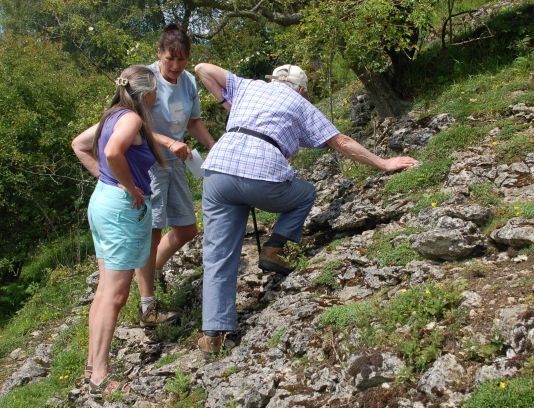 |
Fly orchid
This fly orchid Ophrys insectivora was growing in a very typical location on the fringes of scrubby woodland |
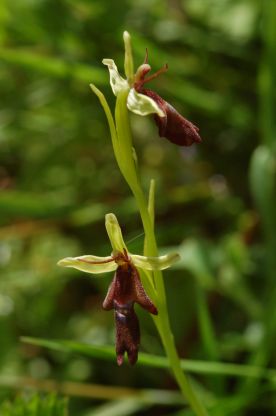 |
Fly orchid (detail)
A close-up of the flower shows its extraordinary resemblance to a fly – this is so that the plant attracts (male) flies to it in the hope of mating with the “female fly”; once there he picks up the pollen from one flower and transfers it to the stigma of another flower, thus fertilising the orchid. |
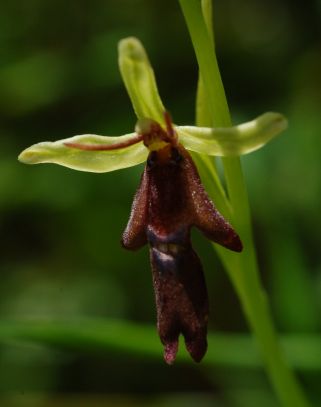 |
Scarlet pimpernel
This nice little pimpernel plant was growing amongst the rocks; rather unusually the flowers were still wide open mid-afternoon (they often close up around lunchtime). Scarlet pimpernel Anagallis arvensis
|
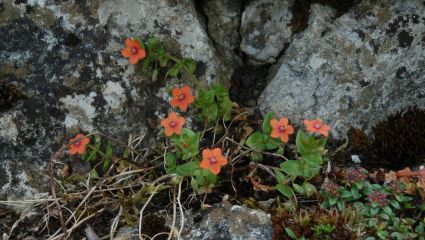 |
Butterfly orchid
This orchid, probably Greater butterfly orchid Platanthera chlorantha, was one of a group growing in deep shade under mixed woodland (mostly ash and hawthorn). Although the flowers do have green tips to the lip and long, slender spur, the overall greenish cast in this picture is caused by the light filtering through the overhanging leaves. |
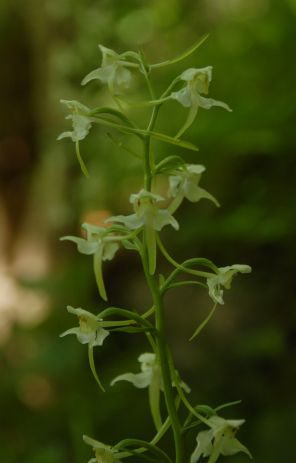 |
Deadly nightshade
A curious-looking plant that is, despite appearances, related to potatoes and tomatoes. It is surprisingly common here, with several very vigorous plants in the newly disturbed earth behind the new car park for the vet’s surgery. My guess is that originally it was grown as a medicinal plant in the physic garden of the nearby nunnery of Keldholme Priory. Deadly nightshade Atropa bella-donna |
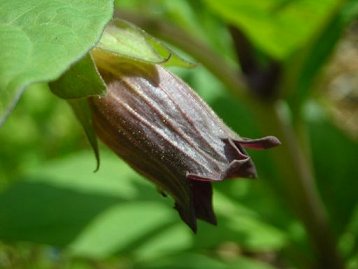 |
Yatts
We then moved on to a site near Yatts Farm (SE808882) that is arguably the best orchid field in Ryedale: a wonderful area of unimproved limestone grassland. This has been known as a site for Burnt-tip orchid for a long time, but the plant(s) had not been seen in flower for at least the past three years. However this year one plant came up trumps, so this was an opportunity not to be missed. I had never seen this delightful little orchid before, and I was completely bowled over by its delicacy and subtle colours (much paler than shown in many books; I now understand there are two forms, one of which is this paler one). The same slope had numerous flowering spikes of fly orchid, twayblades, both butterfly orchids, one fragrant orchid in flower and others in bud, as well as rockroses and milkwort. Dropwort, an uncommon relative of meadowsweet, was growing nearby.
Burnt-tip orchid
This shows the plant, which was about 6" / 15cm tall altogether, though what you see here is about 4" / 10cm, growing in short grassland (the closest thing we have to downland I suppose). The leaves were very inconspicous. Orchis ustulata |
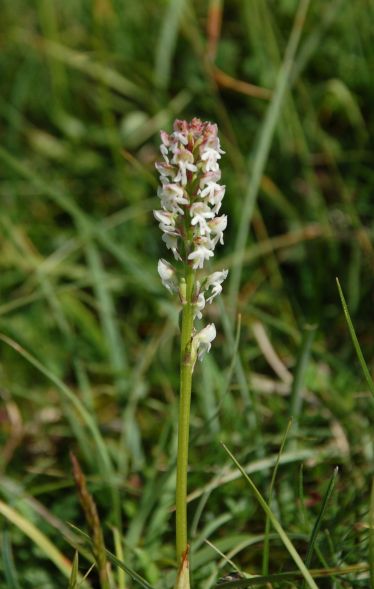 |
Burnt-tip spike
This is the flower spike, showing the flowers with the pink “hood” and lobed lip that looks like a tiny man with red spots that remind me of buttons. In many books the hood is a much darker maroon, especially in bud, and it is this that gives the plant its unusual name – sometimes burnt orchid, sometimes burnt-tip Orchis ustulata. |
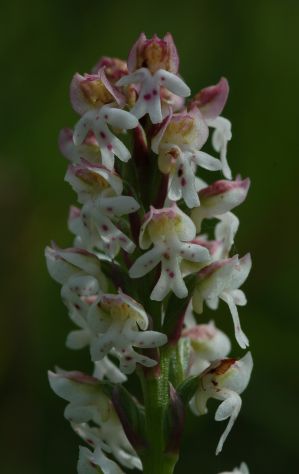 |
Burnt-tip flowers
A closer look at the “little men”. |
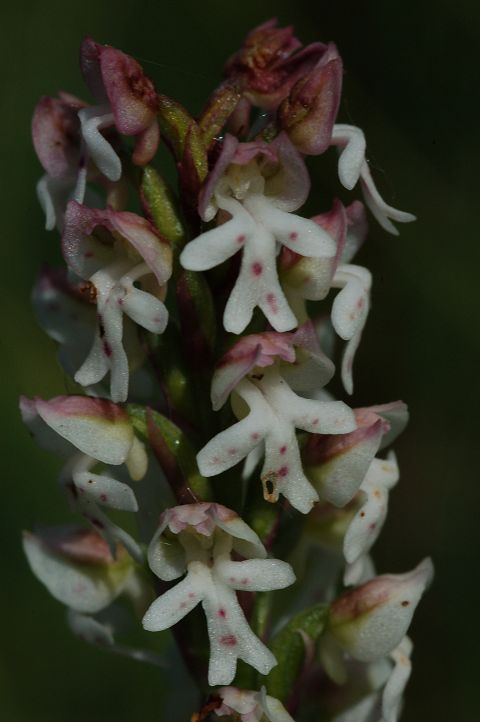 |
Burnt-tip flower detail
A stunning shot of one of the flowers (thanks Adrian!). Orchis ustulata |
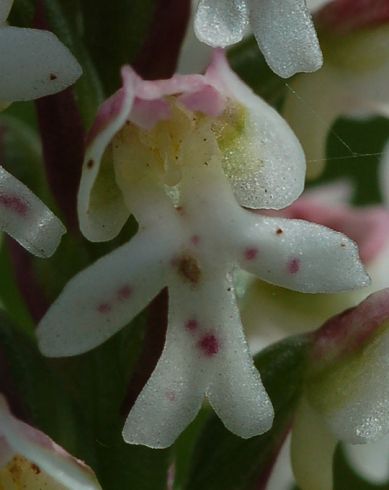 |
Lesser butterfly orchid
A nice spike of lesser butterfly orchid Platanthera bifolia, which is rather daintier and more elegant than its larger cousin, though they can be hard to tell apart and we found one plant that seemed to be intermediate between the two and might have been a hybrid. |
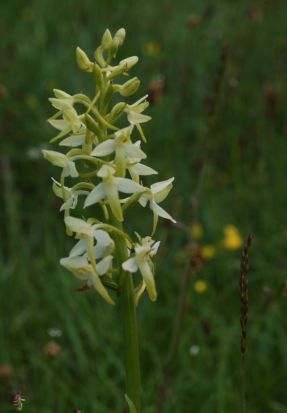 |
Butterfly orchid
Close-up of a butterfly orchid flower – This is Greater butterfly orchid Platanthera chlorantha (thanks to Stuart and Sean for the id – note the diverging, widely-spaced pollinia). |
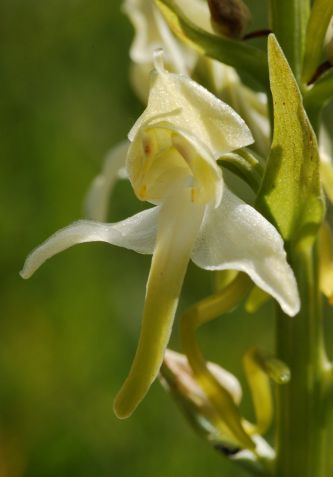 |
Fly orchid
One of the many fly orchids Ophrys insectivora on the bank. |
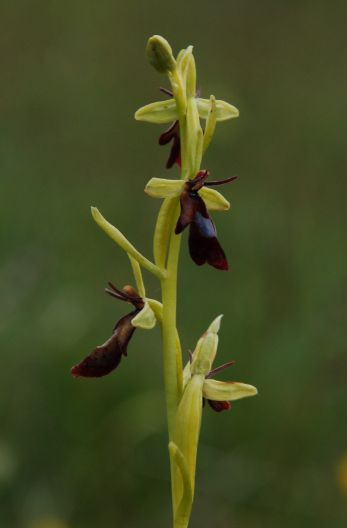 |
Fly orchid detail
...and a wonderful close-up of the flower. Ophrys insectivora |
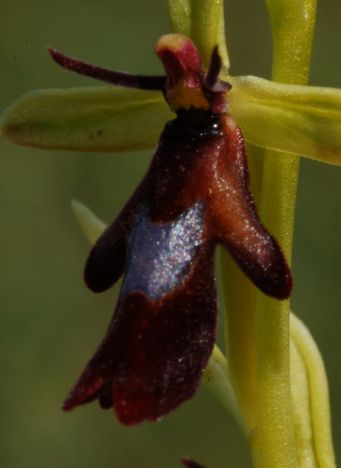 |
Fragrant orchid
The only fragrant orchid Gymnadenia conopsea to be (just) in flower as opposed to in bud. You can see the long, slender, curving spurs characteristic of this species; sadly you cannot smell the equally characteristic carnation-like scent that gives it its name. Thanks to Colin Scrutton this plant is now identified as the heath fragrant orchid Gymnadenia borealis, which used to be considered as a subspecies but is now re-classified as a full species. |
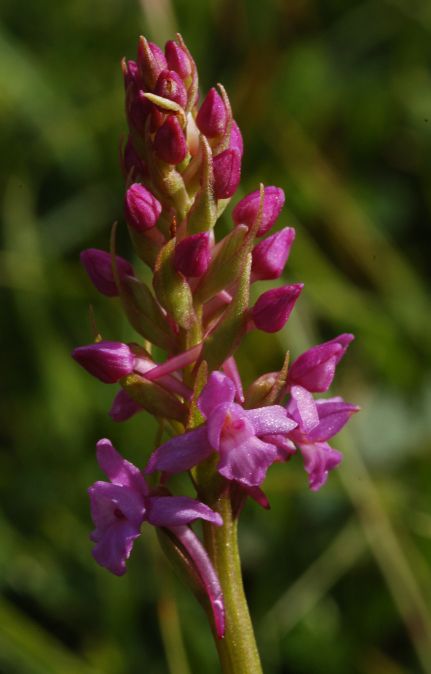 |
Dropwort
We found a few plants of dropwort Filipendula vulgaris not quite out. When the flowers open they are white inside, and a part-open head is very attractive with the mix of pink and white. Despite its Latin name this is not a common plant, at least here in Ryedale. |
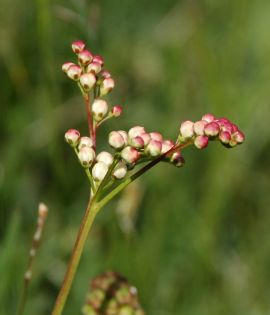 |
Sites like these are a reminder of what much of the limestone belt of the Corallian escarpment must have once been like. Let us hope it is well protected and will continue to support its diverse flora (and fauna dependent on it). I was sad that there were not many insects about – only a few bumblebees and almost no hoverflies or butterflies – on a sunny summer’s afternoon.
Gill Smith June 2009
© Gill Smith June 2009. Pictures © Adrian and Gill Smith 2009
Back to the Top, Trip index and Ryenats home pages















